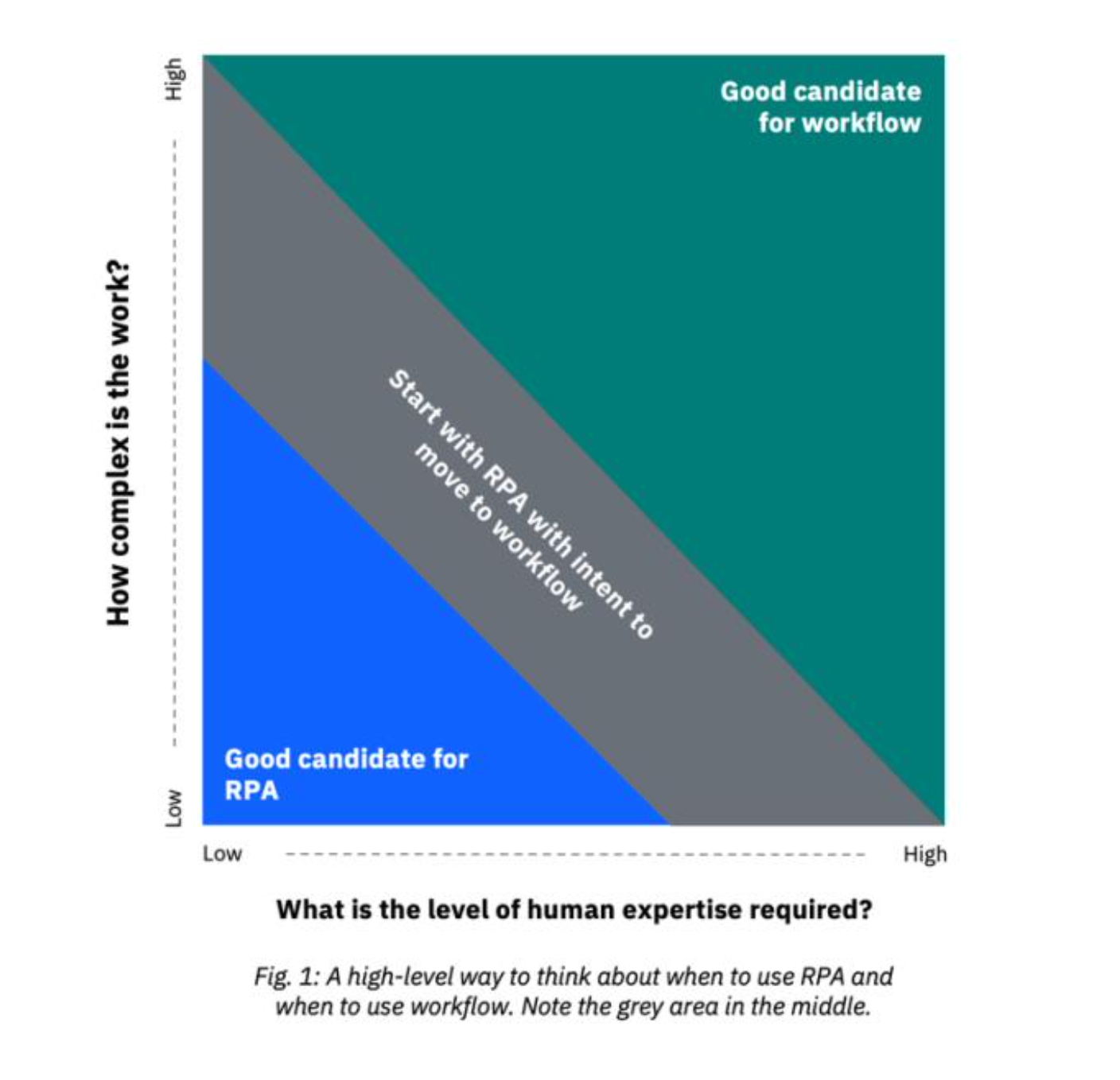RPA vs. Workflow: It’s Not Either/or… It’s Both
Workflow and robotic process automation (RPA) have different strengths and should be used in different situations. This article describes both.
Join the DZone community and get the full member experience.
Join For FreeBoth workflow and robotic process automation (RPA) have an important place, albeit a very different one. It’s not always easy to know which to use and when. The hype around RPA could lead you to believe that RPA is the best choice for everything from order management to oven cleaning. But before you get out the oven cleaner, let’s dig a little deeper.
Typically, we recommend using workflow for state-managed processes that are performed at a high scale and are mission-critical to the business. RPA is often best for repetitive human tasks. There’s also a grey area where you may start with RPA for a quick win — with the goal of moving to workflow to take advantage of its flexibility and robustness. The matrix below can help you frame the question.
Let’s look at the specific benefits of each technology:
Workflow Is Better for Automating High-Scale, Mission-Critical Processes
Complex, mission-critical business processes (e.g., loan origination, claims processing, order management) require coordinating activities across people, departments, and software systems. Workflow provides the capabilities needed to automate long-running processes that require human expertise working in conjunction with various technologies. Complex workflows incorporate routing, rerouting, complex rules, and nested sub-processes. Workflow scales as you increase the amount of automation since modular components are reused across different business processes.
RPA Is Better for Automating Tedious Human Tasks
A top 50 US bank identified 100 candidate activities to automate with RPA. Many of the candidate activities involved regulatory compliance, which, while not difficult, were very tedious and required employees to log in to numerous systems to gather data. According to the bank, “In the past, to create a report, staff had to log in to multiple systems, download the data, and combine it in a spreadsheet. Now, that process is fully automated.” Automating this type of tedious task saved the bank a significant amount of time and freed its people to do more strategic, higher-value work.
Workflow Is More Flexible and Can Be Adapted When Processes Change
Workflow helps organizations remain flexible and responsive as markets and regulations change. Workflow tools provide a visual, simple-to-read representation used to design and execute business processes. The tools are shared by business stakeholders and IT developers. Workflow encourages incremental and modular approaches to automate business processes. As business requirements change, the visual nature and modular approach support the agility needed to react quickly.
RPA Can Help Eliminate “Shadow It”
Business units often make requests to IT to automate their most redundant, repetitive internal processes. IT resources are typically not available to automate such internal processes using workflow. In their frustration waiting for IT to deliver the requested automation, tech-savvy employees in these business units sometimes develop macros or scripts that run outside the normal IT environment. These “shadow IT” processes are often improperly secured and are typically not supportable. RPA provides an approved environment where this type of simple script can be run in a secure environment and within the corporate oversight of the IT department.
RPA Is a Quick Fix When APIs Are Not Available
Application Programming Interfaces (APIs) provide a robust way to integrate systems. APIs are created by writing code, requiring significant development efforts to adapt to the underlying applications. RPA provides an integration option when APIs are unavailable or not practical. RPA is used in lieu of APIs for short-term solutions that have lower risks and smaller data volumes. RPA can be used without the need to change the underlying applications.
Workflow and RPA Should Often Be Used Together
Workflow manages end-to-end business processes that involve a sequence of human and automated tasks, whereas RPA automates individual repetitive tasks. RPA is often part of a workflow implementation but does not replace workflow. Workflow is end-to-end, and RPA can play a significant role within the workflow. For example, a Fortune 100 insurance company used workflow to manage a new customer process. Within the end-to-end workflow of collecting customer information, obtaining approvals, and onboarding the customer, RPA was used to automate specific tasks, such as checking the customer’s credit history.
Wrapping It Up
There is clearly a place for both technologies, and there are clear differences between the two. RPA is faster to implement. Workflow is more flexible. RPA is focused on developers. Workflow is focused on business people. Both are managed by IT, which means neither is part of a “shadow IT” operation.
It’s hard to imagine a company that wouldn’t have the need for both technologies. But while it’s easy to generalize that workflow is for the big stuff and RPA the small stuff, drawing the line in the right place requires thinking through the specifics of the activities to be automated and understanding the characteristics of both of these significant technologies.
Published at DZone with permission of Brian Safron. See the original article here.
Opinions expressed by DZone contributors are their own.

Comments